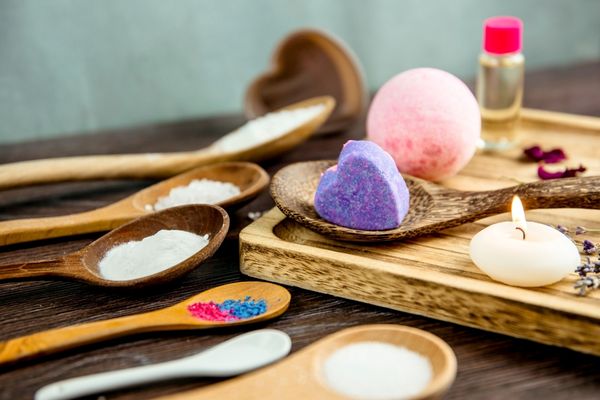Your bath bombs could be sticking to the mold for many reasons. Troubleshooting a sticky bath bomb might require trial and error if you cannot pinpoint the cause exactly. Albeit, this is a common problem when making bath bombs, and there are several ways to fix it.
In this article, we will be discussing the following topics:
- The reasons why your bath bomb may be sticking to the mold.
- How to stop your bath bomb from sticking to the mold.
- A guide to making the perfect bath bomb

Reasons Why Your Bath Bombs may be Sticking to the Mold
Bath bombs are one of the most common DIY bath products, not only because they are easy to formulate but also because it gives you confidence in what you add to your bath water since you combine the materials yourself. It is also much more affordable than buying store bough expensive bath bombs like Lush.
However, the formulation process could come with many issues discouraging you from trying it out again. One of these issues is your bath bombs sticking to the mold.
Here are the reasons why your bath bombs may be sticking to the mold:
- Fragrance or Essential Oil: The fragrance or essential oil blend could affect the process of making the bath bomb. They could cause the bath bomb to stick to the mold and make it difficult to remove the product from the mold. This trouble is common with mixtures with a lot of tangerine or sweet orange essential oil.
- Moisture: Another common reason your bath bomb may stick to the mold is that the mixture contains a lot of moisture and will stick to the mold when you try to remove it because it is too wet.
- Humidity: The climate condition of the environment where you are making the bath bomb could also affect how it comes out. If the humid condition of the environment is too high, it could cause the bath bomb to stick to the mold.
- The type of mold: What the mold is made of usually affects how the bath bomb turns out. The process should be tweaked depending on the type of mold used.
How to Stop Your Bath Bomb from Sticking to the Mold
To prevent any problem from occurring during the process of making a bath bomb at home, it is best to mix all the materials in the right consistency and amount to get a perfect or near-perfect bath bomb in the end. However, you could take these precautions to stop your bath bomb from sticking to the mold.
- If the mold is sticking because of essential or fragrance oil, clean the mold before filling it up with another mixture to prevent build up of the essential oil that could be causing the bath bomb to stick to the mold. Essential oils like tangerine and sweet orange should also be added in moderate and calculated amounts to prevent the sticking of the product to the mold.
- The moisture content of the mixture should not be too much to prevent the bath bomb from sticking to the mold. Just enough is adequate. Also, avoid making bath bombs during rainy seasons or when the humidity of the atmosphere is high.
- If you are using a stainless steel mold, a simple trick can be used. You can add a few drops of Cyclomethicone to the mold halves, then swirl the bath bomb mixture until it coats the mold. This process makes it easy for the bath bomb to come out of the mold. You can also apply Cyclomethicone to the mold halves using a brush.
A Guide to Making the Perfect Bath Bomb
Getting a perfect bath bomb on your first trial is seldom possible. Formulating a disaster, too, doesn’t mean you should give up. In this section, we will look at a guide on how to make a perfect bath bomb. It could be quite tricky to get the right consistency, but the following tips will serve as a guide.
Ingredients List
Dry ingredients
- Baking soda
- Citric acid
- Epsom salt (optional)
Wet ingredients
Water, Essential oil, and carrier oil
The essential oil could be coconut oil, almond oil, witch hazel, rose water, or any other oil you prefer.
- Mix the dry ingredients first before adding the wet ingredients: The dry materials are citric acid, Epsom salt, and baking soda. The Epsom salt and citric acid should be in the same proportion, while the baking soda should be double the ratio of the other dry ingredients.
- Mix the wet ingredients in a separate bowl. Make sure the dry ingredients are mixed thoroughly before you add the wet ingredients to the dry ones little by little. Try to make sure the mixture is not too dry or too wet. Use a spray bottle containing water to spray a little water into the oil mix.
- A simple tip you can use is to check the mixture before you put it into the mold. If you squeeze the mixture in your hand and it forms a shape and doesn’t crumble, then it’s good to go. However, if it doesn’t retain its shape when you release your grip on it, you would have to check the consistency of the mixture.
- You should leave the bath bombs to dry in the mold for several hours or overnight before attempting to remove them.
- Storing bath bombs is another important part of the DIY process. It should be stored in areas with little moisture. Store bath bombs in plastic wraps which are removed before use.
- Remember that bath bombs do expire so it is best to use them within 6 months of making them,
Conclusion
It is difficult to get the perfect bath bomb on your first try. Some issues might arise during the process and after the bath bomb is finished. Bath bombs sticking to the mold is quite a common problem and a cause of worry to those who make DIY bath bombs at home. The solution to this problem is mixing the right amount and consistency of each ingredient and using Cyclomethicone to rub the inside of the steel mold to let the bath bomb slide out easily.
- Can You Put Perfume In A Humidifier? (Read First) - September 17, 2022
- Can You Put Essential Oil In A Steam Mop? (Safety Advice) - September 17, 2022
- How To Make Lavender Oil At Home ( Candles And Diffusers) - September 9, 2022

